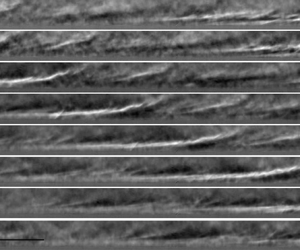Article contents
Characterization of instability mechanisms on sharp and blunt slender cones at Mach 6
Published online by Cambridge University Press: 17 February 2022
Abstract

Experiments are performed to investigate the effect of nose-tip bluntness on the instability mechanisms leading to boundary-layer transition on a  $7^{\circ }$ half-angle cone in a Mach-6 free stream. The development of disturbances is characterized using a combination of high-speed calibrated schlieren images and pressure measurements, and the data are compared with results computed using the parabolized stability equations. The approximately 414 mm long cone model is equipped with an interchangeable nose tip ranging from sharp to 5.08 mm in radius. For nose tips with a radius
$7^{\circ }$ half-angle cone in a Mach-6 free stream. The development of disturbances is characterized using a combination of high-speed calibrated schlieren images and pressure measurements, and the data are compared with results computed using the parabolized stability equations. The approximately 414 mm long cone model is equipped with an interchangeable nose tip ranging from sharp to 5.08 mm in radius. For nose tips with a radius  $R_{N}<2.54\ {\rm mm}$, second-mode instability waves are the dominant mechanism leading to transition. Time-averaged frequency spectra computed from the calibrated schlieren visualizations and pressure measurements are used to compute the second-mode most-amplified frequencies and integrated amplification rates (
$R_{N}<2.54\ {\rm mm}$, second-mode instability waves are the dominant mechanism leading to transition. Time-averaged frequency spectra computed from the calibrated schlieren visualizations and pressure measurements are used to compute the second-mode most-amplified frequencies and integrated amplification rates ( $N$ factors). Good agreement is observed between the measurements and computations in the linear-growth regime for the sharp-nose configuration at each free-stream condition. Additionally, a bispectral analysis identifies quadratic phase locking of frequency content responsible for the growth of higher harmonics. For nose tips of
$N$ factors). Good agreement is observed between the measurements and computations in the linear-growth regime for the sharp-nose configuration at each free-stream condition. Additionally, a bispectral analysis identifies quadratic phase locking of frequency content responsible for the growth of higher harmonics. For nose tips of  $R_{N}\geqslant 2.54\ {\rm mm}$, the schlieren visualization region is upstream of the entropy-layer swallowing length, and second-mode waves are no longer visible within the boundary layer; instead, elongated, steeply inclined features believed to be associated with non-modal instability mechanisms develop between the entropy-layer and boundary-layer edges. Simultaneously acquired surface pressure measurements reveal high-frequency pressure oscillations similar to second-mode instability waves associated with the trailing edge of these non-modal features.
$R_{N}\geqslant 2.54\ {\rm mm}$, the schlieren visualization region is upstream of the entropy-layer swallowing length, and second-mode waves are no longer visible within the boundary layer; instead, elongated, steeply inclined features believed to be associated with non-modal instability mechanisms develop between the entropy-layer and boundary-layer edges. Simultaneously acquired surface pressure measurements reveal high-frequency pressure oscillations similar to second-mode instability waves associated with the trailing edge of these non-modal features.
- Type
- JFM Papers
- Information
- Copyright
- © The Author(s), 2022. Published by Cambridge University Press
References
REFERENCES
- 27
- Cited by



